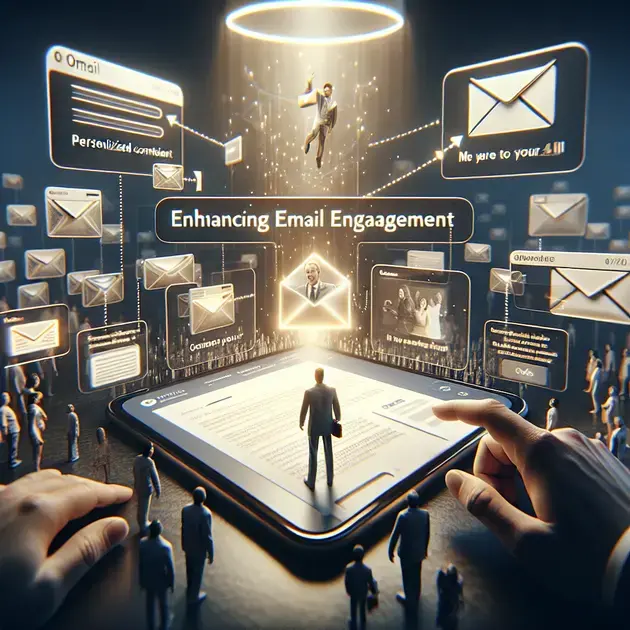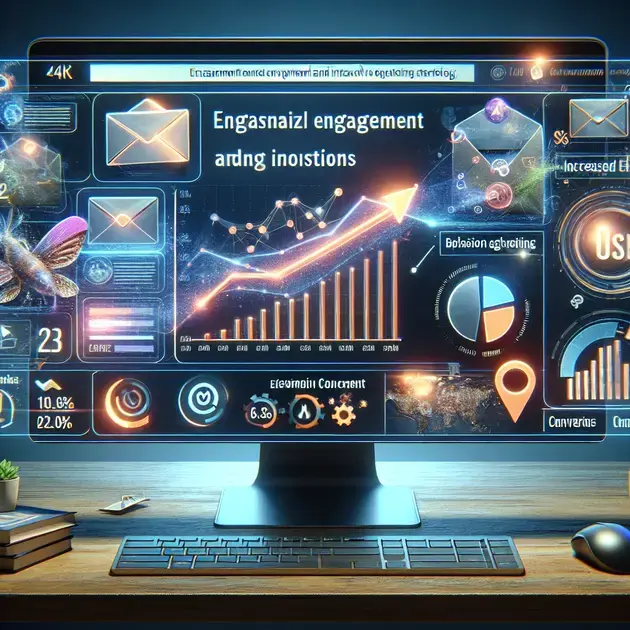Unlocking the Power of Your Email Address can be a game-changer for your online presence. In today’s digital age, email marketing continues to be one of the most effective ways to reach and engage with your audience. By leveraging the full potential of your email address, you can establish a direct line of communication with your customers and prospects, ultimately driving conversions and building brand loyalty.
With the rise of personalized marketing strategies, unlocking the power of your email address allows you to deliver tailored content that resonates with your recipients. By segmenting your email list based on demographics, behaviors, and preferences, you can send targeted campaigns that are more likely to convert. This level of customization not only improves the overall effectiveness of your email marketing efforts but also strengthens customer relationships and enhances the user experience.
Leverage Personalization to Enhance Email Engagement
Personalization is key to increasing email engagement with your audience. By tailoring your emails to individual preferences and behaviors, you can create a more meaningful connection and drive higher open and click-through rates. To leverage personalization effectively, follow these steps:
Step 1: Collect Data
Start by collecting relevant data about your subscribers, such as their demographics, purchase history, and browsing behavior. You can use tools like Google Analytics, Mailchimp, or Salesforce to gather this information.
Step 2: Segment Your Audience
Once you have collected data, segment your audience into different categories based on their interests, location, or behavior. Use email marketing platforms like Constant Contact or Sendinblue to create segmented lists.
Step 3: Tailor Your Content
Now that you have segmented lists, personalize your email content according to each segment’s preferences. Use dynamic content features in platforms like ActiveCampaign or HubSpot to customize your emails for different audience groups.
Step 4: Test and Analyze
Don’t forget to A/B test your personalized emails to see what resonates best with each segment. Use email marketing analytics tools like Litmus or MailerLite to track your email performance and make data-driven decisions for future campaigns.
Step 5: Continuously Improve
Lastly, continue refining your personalization strategy based on the insights and feedback you gather. By constantly optimizing your email content and segmentation, you can ensure that your emails remain relevant and engaging to your audience.
Optimize Email Segmentation for Targeted Campaigns
Effective email segmentation is crucial for running successful targeted campaigns that resonate with your audience. By dividing your email list into specific segments based on demographics, behavior, or preferences, you can deliver more relevant content and drive higher conversion rates. Follow these steps to optimize your email segmentation:
Step 1: Define Your Segmentation Criteria
Start by identifying the key criteria you will use to segment your email list. This could include factors like age, location, past purchases, or engagement level. Use customer data platforms like Segment or BlueConic to manage and segment your audience effectively.
Step 2: Create Segment Categories
Based on your segmentation criteria, create distinct categories or segments within your email list. Tools like MailerLite or ActiveCampaign offer features to easily create and manage different segment groups.
Step 3: Personalize Campaign Content
Once you have your segments in place, tailor your campaign content to each group’s interests and preferences. Use email marketing automation tools like Klaviyo or Campaign Monitor to create dynamic and personalized campaigns for each segment.
Step 4: Monitor and Adjust
Continuously monitor the performance of your segmented campaigns and make adjustments as needed. Use email analytics from platforms like SendGrid or Mailchimp to track key metrics and optimize your segmentation strategy for better results.
Step 5: Test Different Segmentation Strategies
Experiment with various segmentation strategies to see which ones yield the best results for your campaigns. Test different segment criteria, content variations, and timing to find the most effective segmentation approach for your audience.
Enhance Customer Relationships through Tailored Content
Building strong customer relationships is vital for long-term success, and tailored content is a powerful way to connect with your audience on a personal level. By delivering content that resonates with their needs and interests, you can foster loyalty and engagement. Follow these steps to enhance customer relationships through tailored content:
Step 1: Understand Your Audience
Start by gaining a deep understanding of your audience’s preferences, pain points, and motivations. Conduct surveys, analyze social media interactions, or use audience insights tools like Audiense or Sprout Social to capture valuable data.
Step 2: Create Persona Profiles
Based on the audience data you collect, create detailed persona profiles that represent different segments of your customer base. Use tools like Xtensio or HubSpot’s Make My Persona to visualize and document your customer personas.
Step 3: Develop Tailored Content Strategies
With your persona profiles in hand, develop content strategies that speak directly to each segment’s needs and interests. Create personalized email campaigns, blog posts, or social media content using platforms like Canva or CoSchedule to tailor your messaging.
Step 4: Build Interactive Experiences
Engage your audience with interactive and personalized experiences, such as quizzes, surveys, or interactive videos. Tools like Typeform or Interact enable you to create engaging content that fosters two-way communication and strengthens relationships.
Step 5: Solicit Feedback and Iterate
Don’t forget to solicit feedback from your audience on the tailored content you provide. Use survey tools like SurveyMonkey or Google Forms to gather insights and make iterative improvements to your content strategy based on customer feedback.
Boost Email Open Rates with Compelling Subject Lines
Creating compelling subject lines is crucial for boosting email open rates. As an expert in SEO, I understand the importance of crafting subject lines that grab the reader’s attention and entice them to open the email. One strategy to achieve this is by using personalized subject lines that resonate with the recipient. For example, mentioning a customer’s name or referencing their previous purchase history can make the email feel more personal and engaging.
Another effective tactic is to create a sense of urgency or curiosity in the subject line. Phrases like “Limited Time Offer” or “Don’t Miss Out” can prompt the recipient to open the email to learn more. Additionally, incorporating numbers or emojis can help the subject line stand out in a crowded inbox. A subject line that promises valuable information or exclusive deals on “the world’s most expensive wines” is more likely to capture the recipient’s interest.
When crafting subject lines, it’s important to A/B test different variations to see what resonates best with your audience. Analyzing the performance of each subject line can provide valuable insights for future email campaigns and help optimize open rates.
To summarize, boosting email open rates with compelling subject lines requires creativity, personalization, and a deep understanding of your target audience. By following these strategies and continuously refining your approach through testing and analysis, you can significantly improve the success of your email marketing efforts.
Maximize Click-Through Rates with Interactive Email Content
Interactive email content is a powerful way to engage recipients and encourage them to click through to your website or landing page. As an SEO expert, I recognize the value of incorporating interactive elements such as surveys, polls, quizzes, and videos into email campaigns. These dynamic elements not only capture the recipient’s attention but also provide a unique and immersive user experience.
One effective strategy is to include interactive call-to-action buttons that prompt recipients to take a specific action, such as “Explore Now” or “Shop the Collection.” By making it easy for recipients to interact with the email content, you can increase click-through rates and drive conversion rates. Additionally, personalized interactive content based on the recipient’s preferences or behavior can further enhance engagement and encourage clicks.
Utilizing A/B testing to assess the performance of different interactive elements is essential for maximizing click-through rates. By testing variations in design, messaging, and functionality, you can identify the most effective strategies for driving engagement and conversions. Analyzing the data from A/B tests can provide valuable insights for optimizing future email campaigns and improving overall performance.
In conclusion, maximizing click-through rates with interactive email content requires creativity, strategic planning, and a focus on delivering a user-centric experience. By leveraging interactive elements, personalization, and data-driven insights, you can create email campaigns that captivate recipients and drive results.
Utilize A/B Testing to Improve Email Performance
A/B testing is a powerful tool for optimizing email performance and identifying the most effective strategies for engaging recipients. As an expert in SEO, I recommend incorporating A/B testing into your email marketing efforts to systematically evaluate different variables and determine the optimal approach for achieving your goals.
When conducting A/B tests, it’s important to focus on one variable at a time, such as subject lines, content, design, or call-to-action buttons. By testing variations of these elements with a subset of your email list, you can gather data on which approaches resonate best with your audience. For example, testing different subject line formulas related to “the most expensive wines in the world” can help you understand what captures recipients’ attention.
Analyzing the results of A/B tests allows you to make data-driven decisions about how to improve email performance. By identifying patterns and trends in recipient behavior, you can refine your email marketing strategy to maximize open rates, click-through rates, and conversions. Continuously testing and iterating on your email campaigns based on A/B test results is key to achieving long-term success.
In summary, utilizing A/B testing to improve email performance requires a strategic approach, attention to detail, and a commitment to ongoing experimentation. By harnessing the power of data and insights gained from A/B tests, you can optimize your email marketing strategy and drive better results for your business.
Conclusion
Enhancing email open rates involves creating compelling subject lines that resonate with the audience through personalization, urgency, and creativity. By crafting subject lines that address the recipient personally or evoke curiosity, businesses can increase email engagement and drive open rates. A strategic approach to subject line creation, coupled with A/B testing for optimization, is key to boosting email marketing effectiveness.
Maximizing click-through rates is achievable through interactive email content that captivates recipients and encourages action. Incorporating elements like surveys, polls, and personalized call-to-action buttons can significantly enhance user engagement and drive conversions. By leveraging A/B testing to refine interactive content based on performance data, businesses can tailor email campaigns to deliver a user-centric experience that yields results.
Utilizing A/B testing to enhance email performance enables businesses to refine their email marketing strategies based on data-driven insights. By systematically testing variables like subject lines and design elements, businesses can identify the most effective tactics for engaging recipients and improving key metrics. Embracing continuous testing and optimization through A/B testing is crucial for achieving long-term success in email marketing.

